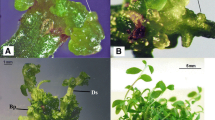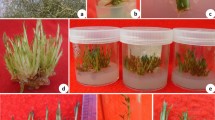Summary
The accumulation of ethylene in headspace of hypocotyl cultures of geranium (Pelargonium × hortorum Bailey) and its possible role in thidiazuron-mediated somatic embryogenesis was investigated. The action of ethylene as determined by various ethylene synthesis and action inhibitors was varied. Silver nitrate (AgNo3), aminoethoxyvinylglycine (AVG), and silver thiosulphate (STS) had no significant influence on the embryogenic response, while 1-methylcyclopropene (1-MCP) applied during the initial 3 d of induction or the expression phase, significantly increased the number of somatic embryos formed. Thidiazuron-treated tissues accumulated large quantities of ethylene within 6 h of culture, but the levels decreased after 12 h and reached very low levels after 3 d in culture. In the presence of acetylsalicylic acid (ASA), the levels of ethylene decreased by 20 to 50% during the first 48 h of culture. Analysis of endogenous auxin, cytokinins, and abscisic acid (ABA) indicated possible interactions of ethylene with other phytohormones during the induction of somatic embryos on geranium hypocotyl explants. Thidiazuron (10 µM) increased, while ASA decreased the levels of endogenous auxin, cytokinins, and abscisic acid during this period of induction.
Similar content being viewed by others
References
Beyer, E. M. A potent inhibitor of ethylene action in plants. Plant Physiol. 58:268–271; 1976.
Biddington, N. L. The influence of ethylene in plant tissue culture. Plant Growth Regul. 11:173–187; 1992.
Biddington, N. L.; Sutterland, R. A.; Robinson, H. T. Silver nitrate increases embryo production in anther cultures of brussel sprouts. Ann. Bot. 62:181–185; 1988.
Gamborg, O. L.; Miller, R. A.; Ojima, K. Nutrient requirements of suspension cultures of soybean root cells. Exp. Cell Res. 50:151–158; 1968.
Gill, R.; Saxena, P. K. Direct somatic embryogenesis and regeneration of plants from seedling explants of peanut (Arachis hypogaea): promotive role of thidiazuron. Can. J. Bot. 70:1186–1192; 1992.
Gill, R.; Saxena, P. K. Somatic embryogenesis in Nicotiana tabacum: induction by TDZ of direct embryo differentiation in leaf disc cultures. Plant Cell Rep. 12:154–159; 1993.
Hutchinson, M. J.; KrishnaRaj, S.; Saxena, P. K. Morphological and physiological changes during thidiazuron-induced somatic embryogenesis in geranium (Pelargonium × hortorum Bailey) hypocotyl cultures. Int. J. Plant Sci. 157:440–446; 1996a.
Hutchinson, M. J.; Murch, S. J.; Saxena, P. K. Morphoregulatory role of thidiazuron: evidence of the involvement of endogenous auxin in thidiazuron-induced somatic embryogenesis of geranium (Pelargonium × hortorum Bailey). J. Plant Physiol.; 149:573–579; 1996b.
Hutchinson, M. J.; Saxena, P. K. Acetylsalicylic acid enhances and synchronizes thidiazuron induced somatic embryogenesis in geranium (Pelargonium × hortorum Bailey) tissue cultures. Plant Cell Rep. 15:512–515; 1996a.
Hutchinson, M. J.; Saxena, P. K. Role of purine metabolism in thidiazuron-induced somatic embryogenesis of geranium (Pelargonium × hortorum Bailey) hypocotyl cultures. Physiol. Plant.; in press: 1996b.
Jones, J. F.; Kende, H. Auxin-induced ethylene biosynthesis in sub-apical stem sections of etiolated seedlings of Pisum sativum L. Planta 146:649–653; 1979.
Kang, B. G.; Yocum, C. S.; Burg, S. P., et al. Ethylene and carbon dioxide mediation of hypocotyl hook-opening response. Science 156:958–959; 1967.
Klee, H. J.; Romano, C. P. The roles of phytohormones in development as studied in transgenic plants. Crit. Rev. Plant Sci. 13:311–324; 1994.
Kochba, J.; Spiegal-Roy, P.; Neumann, H., et al. Stimulation of embryogenesis in Citrus ovular callus by ABA, ethephon, CCC and Alar and its suppression by GA. Z. Pflanzenphysiol. 89:427–432; 1978.
Lau, O.; Yang, S. F. Mechanism of a synergistic effect of kinetin on auxin-induced ethylene production. Plant Physiol. 51:1011–1014; 1973.
Leslie, C. A.; Romani, R. J. Salicylic acid: a new inhibitor of ethylene biosynthesis. Plant Cell Rep. 5:144–146; 1986.
Mattoo, A. K.; White, W. B. Regulation of ethylene biosynthesis. In: Mattoo, A. K.; Suttle, J. C., eds. The plant hormone ethylene. Boca Raton, FL: CRC Press; 1991:21–42.
Murashige, T.; Skoog, F. A revised medium for rapid growth and bioassays with tobacco tissue cultures. Physiol. Plant. 15:473–497; 1962.
Murthy, B. N. S.; Murch, S. J.; Saxena, P. K. Thidiazuron-induced somatic embryogenesis in intact seedlings of peanut (Arachis hypogaea L.): endogenous growth regulator levels and significance of cotyledons. Physiol. Plant. 94:268–276; 1995.
Perl, A.; Aviv, D.; Galun, E. Ethylene and in vitro culture of potato: suppression of ethylene generation vastly improved protoplast yield, plating efficiency and transient expression of an alien gene. Plant Cell Rep. 7:403–406; 1988.
Robinson, K. E. P.; Adams, D. O. The role of ethylene in regeneration of Helianthus annus (sunflower) plants from callus. Physiol. Plant. 71:151–156; 1987.
Roustan, J. P.; Latche, A.; Fallot, J. Control of carrot somatic embryogenesis by AgNO3, an inhibitor of ethylene action: effect on arginine decarboxylase. Plant Sci. 67:89–95; 1990.
Sankhla, N.; Davis, T. D.; Snakhla, D., et al. Reversal of salicylic acid-induced inhibition of growth and organogenesis by thidiazuron. Plant Physiol. 102:180 (Abstract); 1993.
Sato, T.; Theologis, A. Cloning the mRNA encoding 1-aminocyclopropane-1-carboxylase synthase, the key enzyme for ethylene biosynthesis in plants. Proc. Natl. Acad. Sci. USA 86:6621–6625; 1989.
Serek, M.; Sisler, E. C.; Reid, M. S. Novel gaseous inhibitor of ethylene binding prevents ethylene effects in potted flowering plants. J. Am. Soc. Hortic. Sci. 119:1230–1233; 1994.
Smith, D. L.; Krikorian, A. D. pH control of carrot somatic embryogenesis. In: Nijkamp, H. J. J.; Van Der Plas, L. H. W.; Van Aartrijk, J., eds. Progress in plant cell and molecular biology: current advances in plant science, biotechnology and agriculture. Dordrecht, Netherlands: Kluwer Academic Publishers; 1990:449–456.
Songstad, D. D.; Petracek, P. D.; Sams, C. E., et al. Effect of 1-aminocyclo-propane-1-carboxylic acid and aminoethoxyvinylglycine on ethylene emanation and somatic embryogenesis from orchard grass leaf cultures. Plant Cell Rep. 7:677–679; 1989.
Songstad, D. D.; Armstrong, C. L.; Petersen, W. L. AgNO3 increases type 1 callus production from immature embryos of maize inbred B73 and its derivatives. Plant Cell Rep. 9:699–702; 1991.
SAS Institute Inc. SAS users’ guide: statistics, Version 6. Cary, NC: SAS Institute; 1995.
Suttle, J. C. Effect of the defoliant thidiazuron on ethylene evolution from mung bean hypocotyl segments. Plant Physiol. 75:902–907; 1984.
Vain, P.; Flament, P.; Soudain, P. Role of ethylene in embryogenic callus initiation and regeneration in Zea mays L. J. Plant Physiol. 135:537–540; 1989a.
Vain, P.; Yean, H.; Flament, P. Enhancement of production and regeneration of embryogenic type II callus of Zea mays L. by AgNO3. Plant Cell Tissue Organ Cult. 18:143–151; 1989b.
Visser, C.; Qureshi, J. A.; Gill, R., et al. Morphoregulatory role of thidiazuron: substitution of auxin and cytokinin requirement for the induction of somatic embryogenesis in geranium hypocotyl cultures. Plant Physiol. 99:1704–1707; 1992.
Wilson, A. K.; Pickett, F. B.; Turner, J. C., et al. A dominant mutation in Arabidopsis confers resistance to auxin, ethylene and abscisic acid. Mol. & Gen. Genet. 222:377–383; 1990.
Yang, S. F.; Hoffmann, N. E. Ethylene biosynthesis and its regulation in higher plants. Annu. Rev. Plant Physiol. 35:155–189; 1984.
Yip, W. K.; Yang, S. F. Effect of thidiazuron, a cytokinin-active urea derivative, in cytokinin dependent ethylene production systems. Plant Physiol. 80:515–519; 1986.
Author information
Authors and Affiliations
Rights and permissions
About this article
Cite this article
Hutchinson, M.J., Murr, D., Krishnaraj, S. et al. Does ethylene play a role in thidiazuron-regulated somatic embryogenesis of geranium (Pelargonium × hortorum bailey) hypocotyl cultures?. In Vitro Cell.Dev.Biol.-Plant 33, 136–141 (1997). https://doi.org/10.1007/s11627-997-0012-z
Received:
Accepted:
Issue Date:
DOI: https://doi.org/10.1007/s11627-997-0012-z




